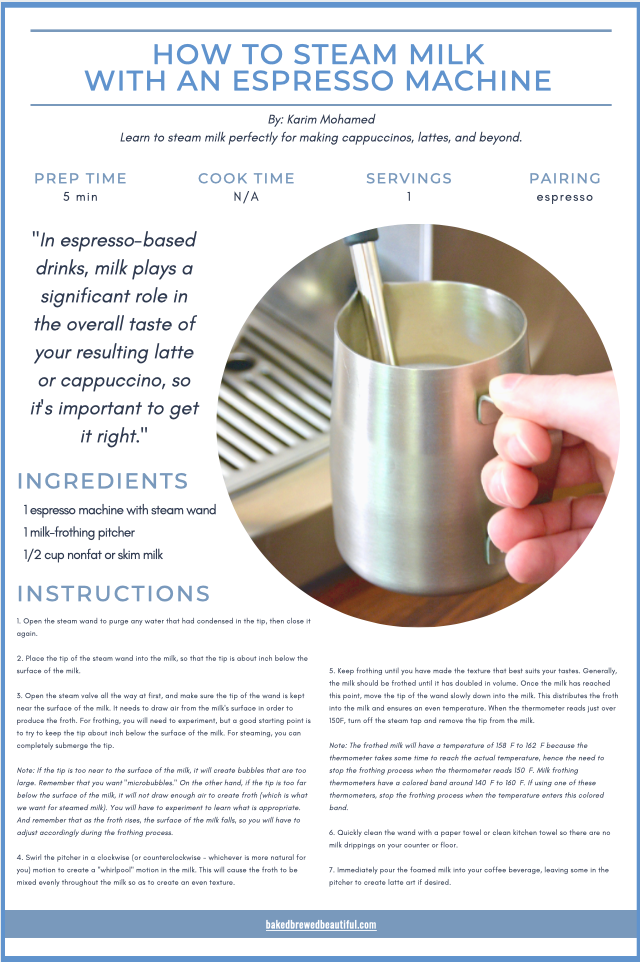Ah, the art of steaming milk for lattes and cappuccinos – a skill that elevates our coffee-drinking experience to new heights. There’s something undeniably special about that velvety texture and creamy goodness, isn’t there? But have you ever wondered how to achieve that perfect, frothy milk every single time? Fear not, dear coffee connoisseurs! In this article, we will guide you through the steps of steaming milk properly, so you can create barista-worthy beverages right in the comfort of your own home. Get ready to impress yourself and your friends with your newfound milk-steaming prowess!
Factors to Consider Before Steaming Milk
Selecting the right milk
When it comes to steaming milk, selecting the right type of milk is crucial to achieving a smooth and creamy texture. Whole milk is typically the most popular choice, thanks to its higher fat content, which results in a richer and more velvety foam. However, if you prefer a lighter option, you can opt for low-fat or skim milk. It’s important to note that different milk alternatives may require different techniques and steam wand settings, so keep that in mind when experimenting with options like soy milk or almond milk.
Choosing the right temperature
The temperature at which you steam your milk is another important factor to consider. The ideal temperature for steaming milk is between 140°F and 160°F (60°C and 70°C). This range allows the milk proteins to properly coagulate and create a velvety texture. It’s crucial to avoid overheating the milk, as it can result in a burnt or scalded taste. Using a thermometer or investing in a milk frothing pitcher with a built-in temperature gauge can help you achieve the perfect temperature every time.
Using the appropriate milk pitcher
The choice of milk pitcher can greatly impact your ability to steam milk effectively. A stainless steel milk pitcher with a tapered spout is your best bet for achieving latte art and controlling the pouring flow. The tapered spout allows for more precision, enabling you to create intricate designs with ease. Additionally, opt for a pitcher with a comfortable handle that provides a secure grip and efficient control during the steaming process.
Steps for Steaming Milk
Preheating the steam wand
Before you begin the steaming process, it’s important to preheat your steam wand. This ensures that any residual water is expelled before introducing the steam into the milk, preventing unwanted splashing or dilution. To preheat the steam wand, simply turn it on for a few seconds, allowing the steam to purge any water that may have collected.
Positioning the steam wand
When steaming milk, the positioning of the steam wand is crucial. It should be positioned just below the surface of the milk, creating a gentle whirlpool effect. This allows the steam to evenly distribute throughout the milk and create a uniform texture. Avoid placing the steam wand too close to the bottom of the pitcher, as this can result in uneven heating and potentially scorching the milk.
Pouring cold milk into the pitcher
Next, pour chilled milk into the milk pitcher, filling it up to about one-third of its capacity. Using cold milk not only helps in achieving a better foam, but it also allows for more time to properly steam the milk without overheating it. Fill the pitcher only with the amount of milk you need for your desired beverage, as attempting to steam too much milk at once can affect the quality and consistency of the foam.
Submerging the steam wand
Once the milk is in the pitcher, carefully submerge the steam wand into the milk, keeping it just below the surface. Ensure that the steam wand is angled slightly off-center to create that whirlpool effect. Positioning the steam wand correctly allows the steam to incorporate air into the milk, resulting in the creation of microfoam.
Creating microfoam
To achieve the perfect texture and consistency, it’s essential to create microfoam during the steaming process. Microfoam refers to a dense and silky foam with microscopic bubbles. To create microfoam, activate the steam wand and gradually lower the pitcher while keeping the steam wand submerged. As the milk expands and starts to foam, position the steam wand closer to the surface to continue incorporating air into the milk. The swirling motion and gradual movement of the pitcher help create a uniform texture.
Wiping and purging the steam wand
After steaming the milk, it’s vital to wipe and purge the steam wand. Use a clean cloth to wipe off any milk residue from the wand, removing any potential buildup. Purging the wand involves briefly opening the steam valve to let out any remaining steam and moisture. This step ensures that the steam wand remains clean and ready for future use.
Tips for Steaming Milk
Practice and experimentation
Steaming milk is an art that requires practice and experimentation to perfect. Each milk variety and steam wand setup may require slight adjustments in technique and temperature to achieve the desired results. Embrace the learning process, and don’t be afraid to experiment with different techniques, milk types, and temperatures until you find what works best for you.
Maintaining cleanliness
Maintaining cleanliness throughout the steaming process is vital to ensure the quality and flavor of your milk. Before each use, make sure your milk pitcher and steam wand are clean and free from any residue. Regularly cleaning your equipment and purging the steam wand after each use helps prevent any buildup that could impact the taste and texture of your steamed milk.
Avoiding overheating
Overheating your milk can result in a burnt or scalded taste, as well as compromise the texture of your foam. Pay close attention to the temperature and never exceed the recommended range. Using a thermometer or a milk frothing pitcher with a built-in temperature gauge can help you achieve precise results and avoid overheating.
Listening to the sound
The sound of the steaming process can provide valuable insights into the progress of your milk. Initially, you’ll hear a low-pitched, continuous hissing sound, indicating the introduction of steam into the milk. As the foam forms and the texture changes, the sound will shift to a subtle hissing or whisper-like sound. At this point, you know you’re close to achieving the desired texture and should be mindful of the temperature to prevent overheating.
Avoiding excessive froth
While achieving a good foam is desirable, it’s important to avoid excessive froth. Excessive froth can result in a coarse and inconsistent texture, making it difficult to pour latte art or achieve a balanced flavor. Pay attention to the steaming process, and stop steaming once you achieve the desired texture and consistency.
Using alternative milk options
Experimenting with alternative milk options can open up a world of possibilities for those with dietary preferences or restrictions. Dairy-free options like soy milk, almond milk, coconut milk, oat milk, or hemp milk can be steamed and frothed, providing an alternative to traditional dairy milk. Just be aware that each alternative milk may require slightly different techniques and temperature adjustments to achieve optimal results.
Common Mistakes to Avoid
Using old or spoiled milk
Using old or spoiled milk can drastically affect the taste and quality of your steamed milk. Always check the expiration date and ensure your milk is fresh before beginning the steaming process. The quality of the milk impacts the flavor and texture of the foam, so using fresh milk is essential for a satisfying result.
Heating the milk too quickly
Heating the milk too quickly can lead to uneven heating and scorching. It’s important to allow the milk to heat gradually while incorporating the steam and creating microfoam. Taking your time during the steaming process will result in a smoother and more velvety texture.
Not aerating the milk properly
Properly aerating the milk is crucial for achieving the desired texture and consistency. Failure to incorporate enough air can result in a flat and thin foam, while introducing too much air can lead to excessive froth. Finding the right balance between incorporating air and creating microfoam requires practice and attentiveness to the steaming process.
Overheating the milk
Overheating the milk can lead to a burnt or scalded taste, ruining the flavor of your steamed milk. Always monitor the temperature and avoid exceeding the recommended range. Remember, it’s better to err on the side of caution and heat the milk gently than risk overheating and compromising the end result.
Neglecting proper equipment maintenance
Neglecting proper equipment maintenance can impact the quality and flavor of your steamed milk. Regularly clean and wipe your milk pitcher and steam wand to prevent any residue buildup. Additionally, make sure to purge the steam wand after each use to remove any remaining steam or moisture. Proper maintenance can prolong the life of your equipment and ensure consistent results.
Troubleshooting Steamed Milk
Milk not steaming properly
If you’re experiencing issues with your milk not steaming properly, there may be several factors at play. Ensure that your steam wand is properly positioned just below the milk’s surface and angled slightly off-center. Check that the steam pressure is sufficient, as low pressure can result in inadequate steam and an inability to properly aerate the milk. Additionally, make sure there are no blockages in the steam wand that could restrict the flow of steam.
Milk taste or smell issues
If your steamed milk has an unpleasant taste or smell, it’s likely due to either using old or spoiled milk or not properly cleaning your equipment. Always check the expiration date and use fresh milk. Additionally, regularly clean and wipe your milk pitcher and steam wand to prevent any residue buildup that could affect the taste and odor of your milk.
Inconsistent foam quality
Inconsistent foam quality can be the result of improper technique or the use of the wrong milk. Ensure that you are properly incorporating air and creating microfoam during the steaming process. Experiment with different milk types to find one that achieves the desired consistency and texture. Various factors, such as fat content and protein levels, can affect the foam quality, so don’t be afraid to try different options.
Curdled milk
Curdled milk can occur if the milk is overheated or if the steam wand is not properly positioned or incorporated into the milk. Avoid overheating the milk by closely monitoring the temperature and stopping the steaming process once the desired temperature is reached. Ensure that the steam wand is properly submerged and creating a gentle whirlpool effect to evenly distribute the heat and steam.
Milk not heating sufficiently
If your milk is not heating sufficiently, it may be due to low steam pressure or inadequate steam wand positioning. Check that the steam pressure is sufficient, as low pressure can result in inadequate heating. Ensure that the steam wand is properly submerged and positioned just below the surface of the milk to maximize heat transfer.
Different Techniques for Steaming Milk
Traditional method
The traditional method of steaming milk involves submerging the steam wand into the milk and gradually incorporating air to create microfoam. This method requires attentive positioning of the steam wand, while carefully swirling the pitcher to achieve uniform texture and consistency.
Purge and steam method
The purge and steam method involves quickly purging the steam wand to remove any residual moisture and contaminants before introducing the steam into the milk. This method ensures a clean start to the steaming process and can help prevent cross-contamination of flavors.
Silent method
The silent method is a technique that involves steaming the milk with minimal noise. It requires positioning the steam wand just below the surface of the milk, minimizing the noise generated by the steam. This method can be useful in noise-sensitive environments or if you prefer a quieter steaming experience.
Alternative steam wands
Some espresso machines offer alternative steam wands that provide different steaming techniques and options. For example, some machines have auto-purge steam wands that automatically release any remaining steam or moisture after each use. Other machines may offer steam wands with adjustable steam pressure settings, allowing for greater control and customization of the steaming process.
Understanding Milk Consistency
Latte milk
Latte milk is steamed to create a silky and creamy texture, with a fine layer of microfoam on top. The texture of latte milk should be smooth and velvety, allowing for easy pouring and latte art designs. Achieving the perfect latte milk consistency requires proper incorporation of air and a gentle whirlpool effect during the steaming process.
Cappuccino milk
Cappuccino milk has a thicker and drier foam compared to latte milk. The foam for cappuccino should be dense and stiff, allowing for a distinct layer of foam to sit on top of the espresso. Achieving the ideal cappuccino milk consistency requires incorporating more air during the steaming process and creating a firmer foam.
Flat white milk
Flat white milk has a velvety texture similar to latte milk, but with a slightly thinner layer of microfoam on top. The foam for a flat white should be finely textured, creating a smooth and balanced combination of milk and espresso. Achieving the perfect flat white milk consistency requires proper incorporation of air and a gentle swirl during the steaming process.
Macchiato milk
Macchiato milk is steamed to achieve a very thin layer of foam, just enough to mark the espresso with a small dot of milk. The texture of macchiato milk should be smooth and velvety, with a minimal amount of microfoam. Achieving the desired macchiato milk consistency requires minimal aeration during the steaming process.
Breve milk
Breve milk, a popular choice for those who enjoy a rich and creamy flavor, is made with steamed half-and-half or cream instead of whole milk. The texture of breve milk should be thick and luxurious, with a dense and rich foam. Achieving the desired breve milk consistency requires incorporating more air during the steaming process and creating a denser foam.
Steaming Milk for Alternative Milk Choices
Soy milk
When steaming soy milk, it’s important to use a technique that minimizes the chances of curdling. Soy milk has a lower protein content than dairy milk, making it more prone to curdling when exposed to high temperatures. Start with a lower steam pressure and avoid overheating the soy milk to maintain its smooth and creamy texture.
Almond milk
Steaming almond milk can be a bit tricky due to its low protein content and tendency to separate. It’s crucial to use a gentle steaming technique and avoid overheating, as almond milk can easily scorch and develop an unpleasant taste. Experiment with different almond milk brands and take note of the ones that steam well without curdling or separating.
Coconut milk
Coconut milk can be steamed to create a rich and creamy texture, perfect for adding a tropical twist to your beverages. However, it’s important to use a technique that prevents the coconut milk from separating or curdling. Start with a lower steam pressure and keep a close eye on the temperature to avoid overheating.
Oat milk
Steaming oat milk requires a technique that maintains its creamy texture without causing curdling or separation. Oat milk tends to thicken when exposed to heat, so it’s important to use a gentle steaming process and avoid overheating. Experiment with different brands of oat milk to find one that steams well and provides a smooth and velvety texture.
Hemp milk
Hemp milk can be steamed to achieve a creamy and nutty flavor profile. It has a higher protein content compared to some other plant-based milks, making it less prone to curdling when heated. However, it’s still important to use a gentle steaming technique and be mindful of the temperature to avoid overheating and compromising the texture of the milk.
Latte Art with Steamed Milk
Pouring the milk for basic designs
To create basic latte art designs, such as a heart or a simple rosetta, start by pouring a steady stream of milk into the center of the espresso while holding the milk pitcher slightly higher. As the cup fills up about halfway, slowly lower the pitcher and gently move it side to side to create the desired design. Practice and experimentation are key to achieving consistent and well-defined basic designs.
Creating latte art designs
To create more intricate and elaborate latte art designs, such as a tulip or a swan, mastering the technique and pouring speed is crucial. Begin by pouring a small amount of milk right in the center of the espresso, then slightly move the pitcher back and forth to create a base. As the base forms, gradually increase the pouring speed while drawing the design with the milk. Keep practicing and refining your technique to achieve more complex and visually stunning latte art designs.
Mastering latte art techniques
Mastering latte art techniques takes time and practice. Start with basic designs and gradually progress to more advanced patterns. Experiment with different pouring techniques, pouring heights, and milk consistency to achieve the desired results. Remember, patience and persistence are key to mastering latte art, so don’t be discouraged if your initial attempts don’t turn out as expected.
Common latte art mistakes
Even the most experienced baristas encounter common mistakes when attempting latte art. Some common mistakes include pouring too fast or too slow, improper milk consistency, and not properly centering the design. To improve your latte art skills, identify the areas where you struggle the most and focus on refining those specific techniques. With practice, you’ll be able to overcome these challenges and achieve beautiful latte art designs.
Steamed Milk for Different Types of Espresso
Espresso for lattes
When steaming milk for lattes, the goal is to create a smooth and creamy texture that complements the espresso’s bold flavor. Use the traditional method of steaming milk to achieve a silky microfoam that blends well with the espresso. The foam should have a velvety texture, allowing for easy pouring and a balanced flavor profile.
Espresso for cappuccinos
Cappuccinos are known for their thick and dense foam, which adds a distinct layer of texture to the espresso. When steaming milk for cappuccinos, incorporate more air during the steaming process to achieve a drier and stiffer foam. The foam should be dense enough to sit on top of the espresso, resulting in a balance between the milk and espresso flavors.
Espresso for macchiatos
The macchiato is a delicate balance between espresso and just a hint of milk. When steaming milk for macchiatos, aim for a very thin layer of foam that is just enough to mark the espresso with a small dot of milk. The texture of the milk should be smooth and velvety, with minimal microfoam. Achieving the desired macchiato milk consistency requires subtle aeration and minimal foam formation.
Espresso for flat whites
Flat whites are characterized by their velvety texture and a fine layer of microfoam. When steaming milk for flat whites, aim for a texture similar to latte milk, but with a slightly thinner layer of foam. The foam should be finely textured, resulting in a smooth and balanced combination of milk and espresso flavors. Be mindful of the steaming process to create microfoam, but avoid excessive froth.
In conclusion, steaming milk properly is essential to achieve the perfect texture, consistency, and flavor for lattes and cappuccinos. Factors such as selecting the right milk, choosing the appropriate temperature, and using the correct milk pitcher all play a significant role in the steaming process. By following the steps for steaming milk, adhering to tips and best practices, avoiding common mistakes, and troubleshooting any issues, you can consistently create beautifully steamed milk for a variety of espresso beverages. Whether you’re aiming for latte art or simply want to enhance the flavor and texture of your favorite espresso drink, mastering the art of steaming milk will elevate your coffee experience to new heights. So grab your milk pitcher, perfect your technique, and enjoy the satisfaction of sipping on a perfectly steamed latte or cappuccino. Cheers to the art of steaming milk!










































